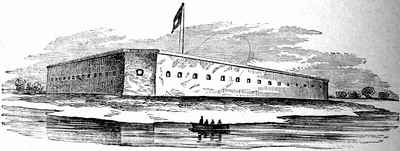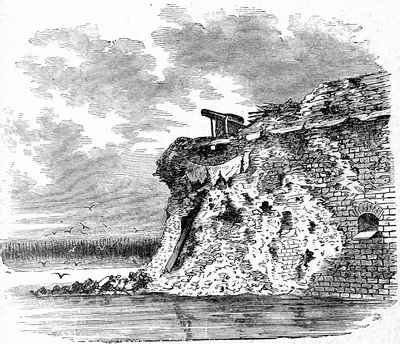
Perry's Saints
or
The Fighting Parson's Regiment
• Title
• Author
• Preface
• Chapter I
• Chapter II
• Chapter III
• Chapter IV
• Chapter V
• Chapter VI
• Chapter VII
• Chapter VIII
• Chapter IX
• Chapter X
• Chapter XI
• Chapter XII
• Chapter XIII
• Chapter XIV
• Chapter XV
• Chapter XVI
• Chapter XVII
• Chapter XVIII
• Chapter XIX
• Chapter XX
PERRY'S SAINTS.
CHAPTER VI.
Planting batteries on Tybee Island. General Gilmore. Listening for the opening gun. Bombardment of Fort Pulaski. Watching the contest from Dawfnskie. Surrender of the fort. Its appearance after the bombardment.
[April, 1862]
| WHILE we were engaged in the work described in the last chapter, General Gilmore was planting his batteries on Tybee Island, which borders the mouth of the Savannah. These were placed from one to two miles distant from Fort Pulaski, and in the work of establishing them, difficulties were encountered similar to those which so thoroughly tested the skill and endurance of our men on the mud islands above. It required the combined efforts of two hundred and fifty men to drag a single mortar from the beach where they were landed, to position, and as several of the batteries were in plain sight from the fort, the work was largely done at night, until the embankments afforded sufficient protection. The fire from the fort was annoying, but less constant and spirited from the confidence of its commander in its security against I the fire of guns so far distant. The value of rifled cannon for siege operations at long range was about to be tested, and while the result in this instance 'was not entirely to the satisfaction of the commandant of the fort, it fully justified the confidence of General Gilmore, for to him belongs the credit of this achievement, from its inception to its final termination. |
By April 6 we became aware that the crisis was approaching, and from that day anxiously listened for the opening gun.
On the 9th, a demand was made for the surrender of the fort, to which the commandant replied, "I was placed here to defend, not to surrender." And he had an opportunity, for on the morning of the 10th the boom of cannon was heard, and from that time until about two o'clock of the afternoon of the following day, the batteries kept up a steady and constant fire. On the first day we could discover little effect, as we watched the progress of the contest from the shore of Dawfuskie, but the next day the frequent clouds of dust arising, especially from the southwest angle of the fort, indicated that progress was being made. During the night the firing had been continued, with intervals of about fifteen minutes, permitting little rest to the garrison, and effectually preventing all attempts to repair or strengthen the fort, and in the morning all the batteries opened and kept up a terrific cannonade, until

FORT PULASKI.
the white flag appeared. Throughout the day the shore was lined with the excited soldiers, especially in the vicinity of Munger's, where a few of us secured places in a large willow tree overhanging the water, and affording an unobstructed view of the conflict. It was not long before a large breach was visible, which gradually widened as the day advanced. The firing from the fort was spirited, but had little effect. Several times the flagstaff was cut away by our shot, and as often replaced, until about 2 P. M. of the 11th, when the firing ceased. Still, we were ignorant of the exact state of affairs, until an accident revealed the fact that the fort had

BREACH IN FORT PULASKI.
surrendered. A sailing vessel was seen slowly drifting towards it. A steamer followed, apparently for the purpose of rendering assistance, but for some reason she seemed to be unmanageable, and gradually approached and passed the fort without drawing its fire. By this we knew that Pulaski was ours, and another entrance for blockade runners was closed.
Soon after its surrender, the officers were from time to time allowed to visit
it. One bright morning, after the details for the day had been made, in company
with several other officers, I was rowed across the river, and spent the day in
the quiet inspection of the fort and surroundings. The effects of the
bombardment were everywhere visible. Guns were dismounted, bomb-proofs torn and
shattered, and the traverses - great mounds of earth for the protection of the
gunners, and to guard against the effects of enfilading shots - were levelled
almost to the ground. The terre-plein was ploughed and furrowed in every
direction, while wide and deep ditches extended across it, to ward off the
effects of bursting shells. In many places the blandages, which were heavy
timbers inclined against the inner wall, although covered with earth to the
depth of three or four feet, were splintered and broken, and large sections of
the walls themselves destroyed. The angle against which the heaviest fire had
been
directed was a gaping mass of ruins, through which at last the shot and shell
drove steadily against the magazine, threatening to envelop fort and garrison in
one common destruction. It was this danger which compelled the surrender.